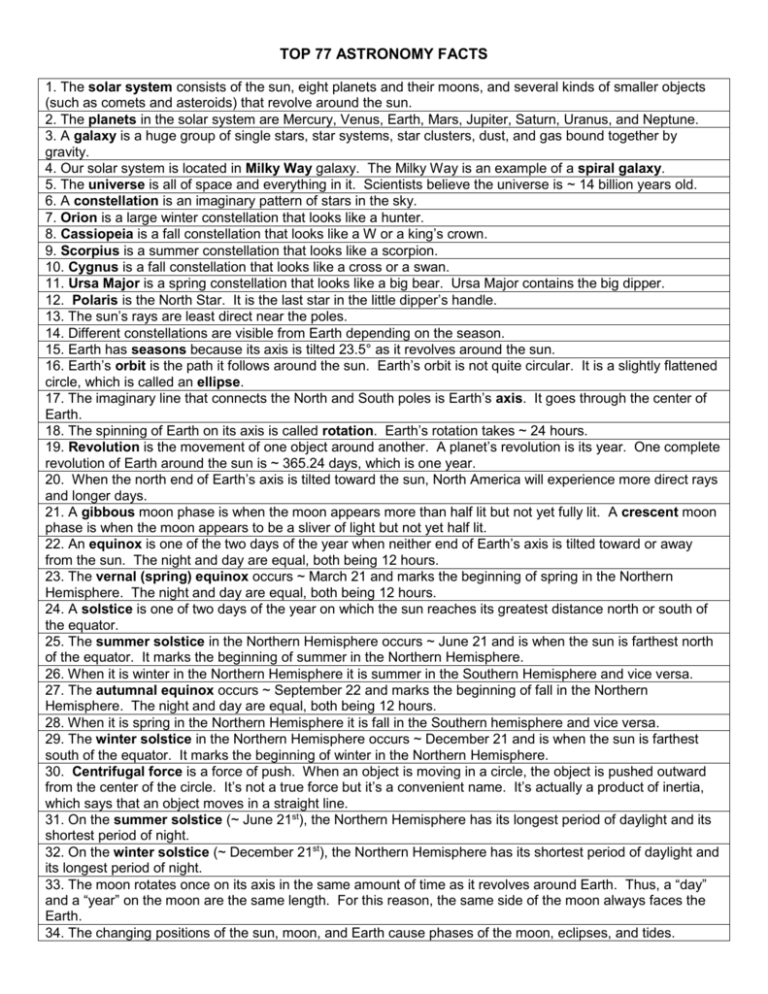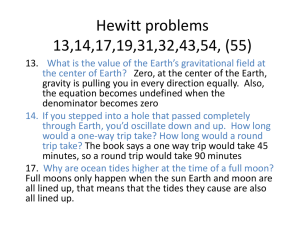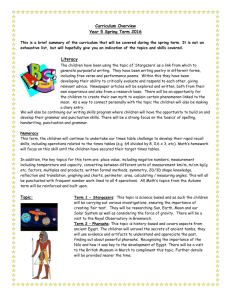Click here for the astronomy facts
advertisement

TOP 77 ASTRONOMY FACTS 1. The solar system consists of the sun, eight planets and their moons, and several kinds of smaller objects (such as comets and asteroids) that revolve around the sun. 2. The planets in the solar system are Mercury, Venus, Earth, Mars, Jupiter, Saturn, Uranus, and Neptune. 3. A galaxy is a huge group of single stars, star systems, star clusters, dust, and gas bound together by gravity. 4. Our solar system is located in Milky Way galaxy. The Milky Way is an example of a spiral galaxy. 5. The universe is all of space and everything in it. Scientists believe the universe is ~ 14 billion years old. 6. A constellation is an imaginary pattern of stars in the sky. 7. Orion is a large winter constellation that looks like a hunter. 8. Cassiopeia is a fall constellation that looks like a W or a king’s crown. 9. Scorpius is a summer constellation that looks like a scorpion. 10. Cygnus is a fall constellation that looks like a cross or a swan. 11. Ursa Major is a spring constellation that looks like a big bear. Ursa Major contains the big dipper. 12. Polaris is the North Star. It is the last star in the little dipper’s handle. 13. The sun’s rays are least direct near the poles. 14. Different constellations are visible from Earth depending on the season. 15. Earth has seasons because its axis is tilted 23.5° as it revolves around the sun. 16. Earth’s orbit is the path it follows around the sun. Earth’s orbit is not quite circular. It is a slightly flattened circle, which is called an ellipse. 17. The imaginary line that connects the North and South poles is Earth’s axis. It goes through the center of Earth. 18. The spinning of Earth on its axis is called rotation. Earth’s rotation takes ~ 24 hours. 19. Revolution is the movement of one object around another. A planet’s revolution is its year. One complete revolution of Earth around the sun is ~ 365.24 days, which is one year. 20. When the north end of Earth’s axis is tilted toward the sun, North America will experience more direct rays and longer days. 21. A gibbous moon phase is when the moon appears more than half lit but not yet fully lit. A crescent moon phase is when the moon appears to be a sliver of light but not yet half lit. 22. An equinox is one of the two days of the year when neither end of Earth’s axis is tilted toward or away from the sun. The night and day are equal, both being 12 hours. 23. The vernal (spring) equinox occurs ~ March 21 and marks the beginning of spring in the Northern Hemisphere. The night and day are equal, both being 12 hours. 24. A solstice is one of two days of the year on which the sun reaches its greatest distance north or south of the equator. 25. The summer solstice in the Northern Hemisphere occurs ~ June 21 and is when the sun is farthest north of the equator. It marks the beginning of summer in the Northern Hemisphere. 26. When it is winter in the Northern Hemisphere it is summer in the Southern Hemisphere and vice versa. 27. The autumnal equinox occurs ~ September 22 and marks the beginning of fall in the Northern Hemisphere. The night and day are equal, both being 12 hours. 28. When it is spring in the Northern Hemisphere it is fall in the Southern hemisphere and vice versa. 29. The winter solstice in the Northern Hemisphere occurs ~ December 21 and is when the sun is farthest south of the equator. It marks the beginning of winter in the Northern Hemisphere. 30. Centrifugal force is a force of push. When an object is moving in a circle, the object is pushed outward from the center of the circle. It’s not a true force but it’s a convenient name. It’s actually a product of inertia, which says that an object moves in a straight line. 31. On the summer solstice (~ June 21st), the Northern Hemisphere has its longest period of daylight and its shortest period of night. 32. On the winter solstice (~ December 21st), the Northern Hemisphere has its shortest period of daylight and its longest period of night. 33. The moon rotates once on its axis in the same amount of time as it revolves around Earth. Thus, a “day” and a “year” on the moon are the same length. For this reason, the same side of the moon always faces the Earth. 34. The changing positions of the sun, moon, and Earth cause phases of the moon, eclipses, and tides. 35. We see the moon because it reflects the light of the sun. The moon does not produce its own light. 36. The half of the moon facing the sun is always in sunlight. The half of the moon that faces Earth is not always the half that is in sunlight. 37. The different shapes of the moon visible from Earth are called phases. 38. The phase of the moon we see depends on how much of the sunlit side of the moon faces Earth. 39. A complete cycle of moon phases takes about 29.5 days to complete. 40. During the first quarter phase and the third quarter phase, we see half of the moon’s lighted side. 41. Summers are hotter because there are longer days and more direct sun rays. 42. During the new moon, the side of the moon facing Earth is not lit because the sun is behind the moon. We see none of the lighted side of the moon so we cannot see the moon in the night sky. 43. Waxing means more of the lighted side of the moon will be visible each night. The visible portion of the moon is growing. 44. Waning means less of the lighted side of the moon will be visible each night. The visible portion of the moon is shrinking. 45. An eclipse is the partial or total blocking of one object in space by another. This happens when the moon’s shadow hits Earth or Earth’s shadow hits the moon. 46. A solar eclipse occurs when the moon passes directly between Earth and the sun, blocking sunlight from Earth. During a solar eclipse the new moon blocks our view of the sun. 47. A lunar eclipse occurs at a full moon when Earth is directly between the moon and the sun. During a lunar eclipse, Earth blocks sunlight from reaching the moon. 48. A tide is the rise and fall of ocean water that occurs every ~ 12.5 hours. 49. Tides are caused by the interaction of Earth, the moon, and the sun. Tides are caused mainly by differences in how much the moon’s gravity pulls on different parts of the Earth. 50. A spring tide occurs when the gravities of the sun and moon combine to produce higher than normal tides. Spring tides occur when the sun, Earth, and the moon are nearly in a line. 51. A neap tide occurs when the sun and moon are at right angles to Earth. High tides are lower than normal and there is little difference between high tide and low tide. 52. Our sun is a medium-sized star located at the outer edge of the Milky Way galaxy. The sun is a hot ball of glowing gas. The sun accounts for 99.8 percent of the solar system’s total mass. The sun’s huge mass causes it to exert a powerful gravitational force throughout the solar system. This gravitational force holds all the planets and other objects in orbit around the sun. 53. A light-year (ly) is the distance light travels in one year, which is ~ 9.5 trillion kilometers (9,460,000,000,000 km). Astronomers use light-years as the unit to measure the distance between stars. In space, light travels at a speed of about 300,000 kilometers per second. 54. Early Greek astronomers developed and believed in a geocentric model of the solar system where Earth is stationary in the center and all the planets and stars revolve around Earth. But they were wrong! 55. Percival Lowell (March 13, 1855 – November 12, 1916) was an author, mathematician, and esteemed astronomer who fueled speculation that there were canals on Mars; founded the Lowell Observatory in Flagstaff, Arizona; and formed the beginning of the work and theories that led to the discovery of Pluto 14 years after his death. 56. Galileo Galilei (February 15, 1564 – January 8, 1642) was an Italian physicist, astronomer, and philosopher who is closely associated with the scientific revolution. His achievements include improvements to the telescope, a variety of astronomical observations, the first and second laws of motion, and effective support for Copernicanism. He has been referred to as the "father of modern astronomy," as the "father of modern physics," and as the "father of science." 57. Nicolaus Copernicus (February 19, 1473 – May 24, 1543) was an astronomer who provided the first modern formulation of a heliocentric (sun-centered) theory of the solar system. His formulation of how the sun, rather than the earth, is at the center of the universe is considered one of the most important scientific hypotheses in history. It came to mark the starting point of modern astronomy and, in turn, of modern science. 58. A telescope is a device that makes distant objects appear closer. The telescope was invented in 1608 and revolutionized astronomy. As technology advances, larger and more powerful telescopes have been designed for modern astronomers to use. 59. An observatory is a building that contains one or more telescopes. 60. Astronomy is the study of space. The most accepted definition of space is that it begins ~ 62 miles (100 km) above the surface of Earth. 61. Asteroids are relatively small collections of rock and carbon or other metal that revolve around the sun. 62. Comets are relatively small collections of dirt and ice. Comets have tails when they are close to the sun. Their tails consist of dust and gas. 63. Meteoroids are small particles from an asteroid or comet that revolve around the sun. 64. Meteors are meteoroids that burn up as they enter Earth’s atmosphere. They are also known as shooting stars. 65. Meteorites are meteoroids that survive their passage through Earth’s atmosphere and end up crashing into Earth. 66. Gravity is a force that pulls objects. The sun is the largest thing in the solar system so it has the most gravity. However, the sun is so far away from Earth (93 million miles) that the moon, which is many times smaller than the sun, has a bigger affect on Earth than the sun does. Therefore, gravity is affected by mass and distance! I know this stuff is amazing, isn’t it?!? 67. The internal structure of the sun consists of the inner core, radiative zone, and convection zone (from inside to outside). Oh, and the sun is very hot. 68. The outer structure of the sun consists of the photosphere, chromosphere, and corona (from inside to outside). Did I mention the sun is hot? 69. Sunspots are large magnetic fields located on the sun. Sunspots usually come in pairs (one positively charged and the other negatively charged). Sunspots last for several days to several weeks, depending on their size. And, as mentioned above, the sun is quite warm. 70. The big bang theory states that before the universe, there was nothing. But then about 14 billion years ago, a black hole had such intense pressure that it began to expand. No one knows where the black hole came from or what caused all the pressure. However, the black hole continued to expand, creating the universe. The universe experienced several cycles of cooling and heating until it became the size and temperature it is today. The universe is still expanding and we know this because galaxies are getting farther away from each other. 71. Ebb and Flow is a term used when you are talking about something growing and then declining. For example, the ebb and flow of the tides refers to when the water level is increasing on the beach because of high tide and then decreasing on the beach because of low tide. 72. An astronomical unit, or AU, is the distance between the sun and Earth, which is 93 million miles. Those planets closer to the sun have less than one AU and the planets farther from the sun have more than one AU. 73. A satellite is an object that revolves around another object. One of the sun’s satellites is Earth. Earth’s satellite is the moon. 74. Velocity indicates an object’s speed and direction. A car traveling down Pecos Road toward Chandler Mall is going 65mph East, which is its velocity. Earth’s rotation is ~1,000 mph so its velocity is 1,000mph counterclockwise (East). 75. The life cycle of a star is as follows: protostar main sequence red giant white dwarf, neutron star, or black hole depending on the core’s mass. 76. The umbra is the darker part of the shadow. This comes in handy when we discuss eclipses. 77. The penumbra is the lighter part of the shadow. This comes in handy when we discuss eclipses.








